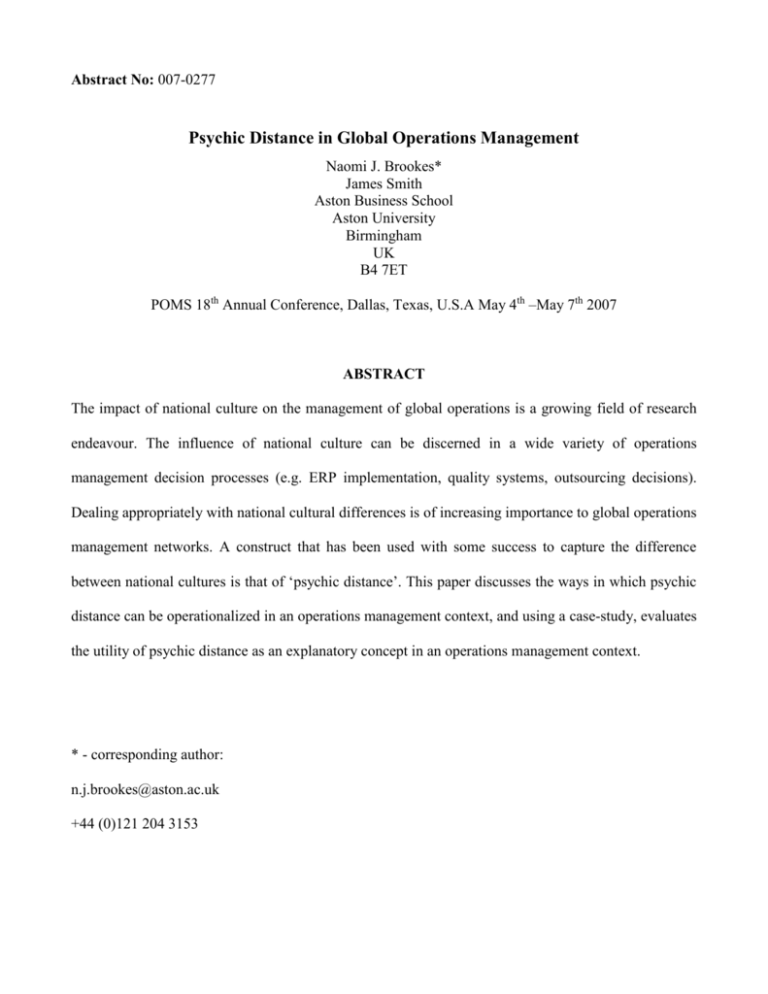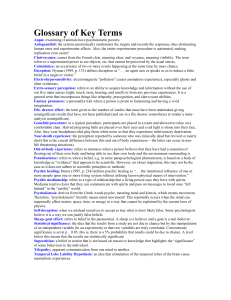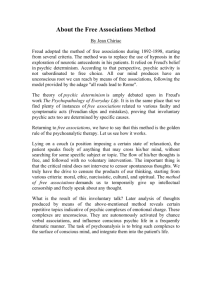007-0277 - Pomsmeetings.org
advertisement

Abstract No: 007-0277 Psychic Distance in Global Operations Management Naomi J. Brookes* James Smith Aston Business School Aston University Birmingham UK B4 7ET POMS 18th Annual Conference, Dallas, Texas, U.S.A May 4th –May 7th 2007 ABSTRACT The impact of national culture on the management of global operations is a growing field of research endeavour. The influence of national culture can be discerned in a wide variety of operations management decision processes (e.g. ERP implementation, quality systems, outsourcing decisions). Dealing appropriately with national cultural differences is of increasing importance to global operations management networks. A construct that has been used with some success to capture the difference between national cultures is that of ‘psychic distance’. This paper discusses the ways in which psychic distance can be operationalized in an operations management context, and using a case-study, evaluates the utility of psychic distance as an explanatory concept in an operations management context. * - corresponding author: n.j.brookes@aston.ac.uk +44 (0)121 204 3153 1.0) INTRODUCTION AND AIMS 1.1) National Culture and Operations Management In recent years, a significant body of research has been established that views national culture as an important paradigm through which to view operations management. The impact of national culture has been discerned on a wide variety of aspects of operations management: Planning and Logistics: A number of studies have identified the importance of national culture in ERP systems implementation(Sheu, Chae et al. 2004; Bendoly, Bachrach et al. 2006) Quality Improvement: Studies have reviewed the conceptualisation of quality concepts by different national cultures(Robert, Probst et al. 2000; Flynn and Saladin 2006) or in terms of implementation of TQM(Katz, Krumwiede et al. 1998; Mathews, Ueno et al. 2001) Decision making: Researchers have identified links between decision-making processes ( and the information sources that support these processes) and national culture(Ford, Connelly et al. 2003; Carr 2005; Zhao, Flynn et al. 2006) Researchers have also identified links between national cultures and cross-company influences such as innovation and creativity(Jones and Davis 2000), human resource management(Ferner, Quintanilla et al. 2001), managerial emotional intelligence(Shipper, Kincaid et al. 2003) and organizational learning(Berrell, Gloet et al. 2002). In undertaking these investigations, researchers have frequently used a geographic entity (a country or a region) as their unit of cultural analysis. Pagell et al have identified problems with this approach(Pagell, Katz et al. 2005). Their research has identified that constructs of national culture employed by Hofstede are better predictors of operational decision-making than straightforward spatial groupings. They state that: “To successfully manage an international supply chain, it takes more than knowing that operations decisions are made differently in different countries or regions. Managers must realize what issues make international operations management different and challenging. Specifically, managers must understand how and what dimensions of national culture influence operations decisions. Such understanding will better prepare multi-national companies to more effectively manage the global supply chain. Based on the cultural dimensions suggested by Hofstede (1980) and Trompenaars (1994), this study shows that culture allows us to understand decision-making in manner which is not possible with regional comparisons .……………………… Finally and most importantly, future studies need to move beyond the macro level theory that focuses on whether culture matters, to the more micro level question focusing on how culture matters. Our initial analyses indicate that culture influences all four operational decision areas we examined. Theory must now be proposed and tested to examine how and why culture influences individual operational activities” 1.2) Psychic Distance as an Explanatory Construct In the search for the detailed understanding of the mechanisms by which national culture influences operations management practices, it may be useful to ‘widen the net’ in terms of constructs of national culture. Researchers into the internationalisation of companies have employed conceptualizations of national culture beyond those articulated by Hofstede and Trompanaars. One of the more widely used ways of thinking about international culture is the concept of ‘psychic distance’. The term psychic distance was first used by Beckerman(Beckerman 1956) and represented the degree to which an actor in one national culture feels ‘comfortable’ in dealing with an actor from another culture. The term became more widely known through the work of the Uppsala School (e.g. (Johanson and Vahlne 1977)) where it was used to indicate the sum of factors that prevent information flowing from one national environment to another. They used psychic distance to explain the ways in which firms choose to internationalize their operations and, as such, psychic distance has become established as an important explanatory variable in the internationalisation process e.g. (Fletcher and Bohn 1998; Child, Ng et al. 2002). Increasingly, ‘psychic distance’ has been used as a predictor of adaptations that companies make to their operations when they move them to other countries e.g. (Conway and Swift 2000; Gurung and Prater 2006). The question arises, therefore, if psychic distance can be a useful indicator of adaptation prior to internationalisation, could it also be useful as an explanatory construct for the differences in global operations management practices that Pagell et. al (op. cit) indicate need further investigation? Psychic distance is a useful construct in that it gauges the degree of difference between cultures. On an intuitive level, it would seem sensible to propose that the greater the cultural difference between operational facilities the more problems that they are likely to encounter in interfacing with each other. Extraploating further, psychic distance would therefore be of particular use in diagnosing problems in global supply chains. Before psychic distance can be used as an explanatory construct, however, difficulties in its operationalization have to be faced. Psychic distance has customarily been operationalized as a composite index of a cultural archetype ( often based on Hofstede) and other national characteristics e.g. (Kogut and Singh 1988; Evans and Mavondo 2002). However other researchers have questioned the usefulness of a composite index approach in conceptualizing psychic distance(Stottinger and Schlegelmilch 2000) and recent research has highlighted the lack of predictive capability of some of the customary ‘psychic distance’ constituents(Dow and Karunaratna 2006). 1.3) Aims of the Investigation The aims of the investigation reported in this paper were two-fold : i) to explore the operationalization of the construct of psychic distance in the context of operations management ii) to explore if ‘psychic distance’ was a useful explanatory construct in understanding the impact of national culture on operations management. Given the exploratory nature of these aims, empirical evidence was gathered using a case-study investigation of the interactions between the global operations facilities of a manufacturing MNC with its HQ based in the UK. 2.0) THE CASE STUDY INVESTIGATION 2.1)Aims and Background The case study was undertaken in a multi-national manufacturing company whose HQ was based in the UK and with operational units in five other countries. The case-study company has a turnover of ~$200M p.a. and employs 2,000 people globally. The case-study company has made a series of Foreign Direct Investments over the past thirty years and is actively considering further FDI to reduce costs and be closer to its markets. The company is highly vertically intergrated with the output of one operational unit acting as an input to the next. It therefore is highly motivated to insure efficient communication and problem solving along its internal supply chain. The case-study investigation focused on operational facilities in the UK, Portugal, India, Australia and the USA. 2.2 Data Collection This case-study comprised two phases of primary data collection which related specifically to the case study organisation: 1. Measurement of the psychic distance between global facilities using a questionnaire based measurement tool. 2. Recording operational problems perceived to have been caused by cultural issues through semistructured interviewing. Key to the success of this research was the effectiveness of the questionnaire and the willingness of the respondents to respond openly to the semi-structured interview approach. Anonymity and the trust derived from an existing good working relationship between the researchers and the respondents were key to minimising these obstacles. The psychic distance between different operational sites was evaluated by key personnel based in each site (India, Australia , Portugal and the USA) with a matched set of individuals based in the case-study company’s UK HQ. Respondents were selected according to the following criteria: a). They were based at that operational facility and had resided in that country, b). They had significant experience of interfacing with the UK HQ c) They were substantively responsible for operational performance The respondents to the questionnaire were asked to measure on a scale of 1 to 5 (Likert type scale) how they perceived the MNC’s HQ to be different to their own site across this range of specific aspects of culture and business practice. The Likert type scale classification was graded “Similar” = 1; “Slightly Different” = 2; “Moderately Different” = 3; “Very Different” = 4; “Totally Different” = 5. The questionnaire was designed based on the work of Evans & Mavondo (2002), and Evans, Mavondo & Treadgold (2000). In this work they described their operationalisation of the psychic distance concept using a questionnaire to measure the psychic distance present in the international retailing sector. They used the work of Hofstede to create a list of key cultural difference parameters he had used to determine differences between nations i.e. Power-Distance, Individualism, Masculinity, Uncertainty Avoidance and Long-Term Orientation. They added to this the additional parameters of Political/Legal, Business Practice and Language differences. In order to extend this operationalisation of the psychic distance concept the researcher added the parameters of Environmental and SupplyChain differences. Further development of the operationalisation was derived from applying the tool to a single manufacturing company as opposed to the wider international retailing sector. A critical incident approach was adopted for the second part of the primary research as described by Weber (Weber 1985). In this technique the individuals that had completed the questionnaires were asked to recall specific critical incidents and explain the circumstances around the occurrence of those incidents. This allowed the researchers to interpret any links between these operational problems and the psychic distance measurements. 2.3 Data Analysis and Discussion Table 1 shows the results of the questionnaires to elicit the psychic distance measurement between the UK and the other operational facilities. Operational Facility Psychic Distance with the UK* Nationality of Psychic Distance Assessors Power Distance Individualism Masculinity Uncertainty Avoidance Long-term Orienttation Political Legal Environmental Supply-Chain Business Practice Language USA 2.1 UK 1 2 1.5 1.5 2.5 1 1.5 2 1.5 1 Australia 1.7 Portugal 2.0 India 3.5 USA UK Australia UK Portugal UK India 4.5 1 3 2 2 5 4.5 3.5 2 3 2.5 2 4 4.5 1.5 2 2 2.5 3 4 3.5 2 2 2.5 2.5 1.5 4 3 2.5 3 1.5 1 2 3.5 2.5 2.5 1 1 1 2 3 4 4 1 1 1 1 1.5 2.5 3.5 1.5 2 1.5 2 2.5 3 1.5 1.5 1 2 1 3 4 1 1 1 4 4 4 3.5 Table 1: Psychic Distance Between Operational Facilities * Psychic Distance = mean of each individual element of psychic distance)/10 This indicates that the psychic distance between the UK and the USA, Portugal and India indicates ‘slightly different’ national cultures whereas the psychic distance between the UK and India lies between ‘moderately different’ and ‘very different.’ On the whole, this table demonstrates a significant degree of concurrence between the non-UK and the UK’s perception of the psychic distance that lies between them. The interesting disparity lies between the UK’s view psychic distance between itself and the USA and the USA’s perception. This disparity may be due to the UK’s familiarity with what it perceives as US culture as garnered through the large influence of American media in the UK. It also may have been influenced by the fact that the USA operational facility was based in the South of the USA which has a distinctly different regional culture than that of the North of the USA which may be the predominant version of American culture portrayed in the UK. Table 2 shows the range of identified critical operational incidents that could be related to differences Delay in the timely delivery of new Engineering and Project Developments Protracted approval of process improvement changes Limited success in management style introducing an Lack of success in optimising Production Plans and Manufacturing Processes Progress of Engineering improvements Problems with delivery to an agreed budget with the UK Training to assist technology transfer from UK to India Labour dispute associated with inappropriate motivational mechanisms Limited action execution Masculinity Uncertainty Avoidance LTO Pol/Legal Environmental Supply-Chain Business Practice Language 3.5 1.5 2 2.5 2.5 4 3.5 1.5 1 X X X X Aust 3 1.7 X 3 2 2.5 1.5 1 1 2 1 1 X Port Sub-optimisation of Transit Costs 4.5 2.1 ‘empowered’ Industrial Dispute Effect of January Shut-down Individualism USA Power Distance Site & Operational Critical Incident Distance Psychic in psychic distance. 2 2 3 1.5 2 2 1 2 1 4 2.5 3 4 3.5 X 2.0 India 4.5 3.5 X 4.5 3.5 3 2.5 4 X X X X X X X X Table 2: Operational Critical Incidents and Their Relationship to Psychic Distance Some critical incidents were clearly rooted in the conceptualization of psychic distance employed in this case-study investigation. For example, the power distance component of this investigation’s operationalisation of psychic distance appeared to have a significant impact between the UK and India. The interviewee highlighted that respect for those in positions of higher authority meant that their decisions were not questioned One of the interviewees stated: “We were pressurised into an unachievable budget and whereas in UK we just would not agree, the approach here has been to try and achieve it” Power distance was also arguably impactive on the inability to train and effectively to transfer technology. Some of the training was undertaken by UK machine operatives sent out to India. One of the interviewees stated: “Because some (Indian) staff have perceived themselves to be of higher social status because of their academic qualification they have ignored the skills and knowledge of the trainer and questioned the validity of the training being given”. Power distance was also judged to have an effect on the way that actions were executed. High tolerance of power distance meant that employees viewed it as a managerial responsibility to make sure that decisions were executed: “the UK way would be to engender a feeling of responsibility in the person to achieve a goal. In India if an action is agreed it is seen as being required by the senior party and therefore the responsibility of the senior individual to push to make it happen” Evidence was also extant of links between the political/legal and business practices elements of psychic distance and operational issues. In Portugal, the operations facility was forced to follow guidelines for loading in outward bound logistics that whilst compliant with UK HQ regulations (which followed UK Health and Safety legislation) were much stricter than those in operation in Portugal. This meant they could load less per trip than possible under Portuguese legislation and hence logistics cost more. In Australia, a January shutdown (in line with their summer holidays) was standard business practice: the case-study companies HQ did not adequately take it into account. These critical incidents are interesting as they demonstrate that, even between countries with a comparatively low psychic distance, operational problems rooted in psychic distance can still occur. Inferring quantitative relationships from qualitative data is dangerous but it is interesting to note that the countries in which showed the highest number of critical incidents related to psychic distance were the USA and India. There are clearly numerous reasons why this situation could have occurred that are not related to psychic distance explanations. However, India did demonstrate the highest psychic distance overall and the highest number of operational critical incidents relating to psychic distance. This may suggest that the higher the psychic distance between countries, the more likely it is to encounter operational problems relating to national culture. The second highest country was the USA which on a prima facie basis appears to counter this supposition as it only demonstrates a ‘slightly different’ psychic distance. This supports the work of O’Grady and Lane who show that the smaller difference in psychic distance cause firms to ‘trip-up’ as they assume cultures are the same and therefore fail to pick-up on minor but highly impactive cultural impacts on their operations (O Grady and Lane 1996). An alternative explanation of this phenomenon may lie in the way in which the average value for psychic distance masked the very different levels between UK and USA respondents. This meant that the UK felt that it did not have to adapt its operational practices whereas that USA operational facility felt that their culture was very different. This may indicate that a disparity in perception of psychic distance per se is an indicator of the propensity for culturally based operational performance issues. The case study investigation also highlighted operational critical incidents that were clearly culturally related but could not be linked to this investigation’s conceptualization of psychic distance. For example, the interviewee based in the Indian facility stated: “A normal discussion to an Indian can appear to be an argument to a UK national ………. Indians like to discuss and theorise and do this by communicating emotively” He suggested that this tendency contributed to the Indian facility’s inability to effectively communicate required process improvements to the UK. A cross-interview feature was the reported difficulty in getting swift responses to requests from the UK HQ facility. This may not only be due to a ‘national’ psychic distance but also to an organisational ‘psychic distance’ between and HQ and its satellite facilities. 3.0) CONCLUSIONS The investigation reported in this paper has taken as its premise the utility of ‘psychic distance’ as an explanatory construct for the impact of national culture on operations management. In particular, the investigation has explored the issues in operationalizing the construct of psychic distance in an operations management context and the value of psychic distance in explaining critical operational incidents. The investigation has shown that psychic distance can be successfully operationalised using a composite index approach in an operations management context both in terms of the constituents of the composite index and the willingness and ability of operations management practitioners to respond to this operationalization. The investigation has also indicated that a unitary index of psychic distance may have some value. (The number of operational problems, as characterised by the number of identified critical incidents, bore some relationship to the absolute value of psychic distance.) However, individual critical operational incidents could also be related to individual elements of the psychic distance composite measurement which may mean that psychic distance will need to be deconstructed to give the detailed understanding that Pagell et. al (op. cit.) are seeking. Furthermore, some critical incidents were clearly rooted in cultural differences which were not captured in the operationalization of psychic distance based on the work of Evans and Mavondo (op. cit.) used in this investigation. This suggests that a wider investigation into the constituents of psychic distance in an operations management context will need to take place. The external validity of the findings of this investigation are obviously limited by its case-study methodology. However, the investigation does provide enough evidence to indicate that further research into the usefulness of psychic distances in understanding the practice of operations management in different national cultures should take place. REFERENCES. Beckerman, W. (1956). "Distance and the pattern of Intra-European trade." Review of Economics and Statistics 38(1): 31-40. Bendoly, E., D. Bachrach, G. , et al. (2006). "ERP in the minds of supervisors." International Journal of Operations & Production Management 26(5): 558. Berrell, M., M. Gloet, et al. (2002). "Organisational learning in international joint ventures: Implications for management development." The Journal of Management Development 21(2): 83. Carr, C. (2005). "Are German, Japanese and Anglo-Saxon Strategic Decision Styles Still Divergent in the Context of Globalization?" The Journal of Management Studies 42(6): 1155. Child, J., S. H. Ng, et al. (2002). "Psychic distance and internationalization: Evidence from Hong Kong firms." International Studies of Management & Organization 32(1): 36. Conway, T. and J. Swift, S. (2000). "International relationship marketing - The importance of psychic distance." European Journal of Marketing 34(11/12): 1391. Dow, D. and A. Karunaratna (2006). "Developing a multidimensional instrument to measure psychic distance stimuli." Journal of International Business Studies 37(5): 578. Evans, J. and F. Mavondo, T. (2002). "Psychic distance and organizational performance: An empirical examination of international retailing operations." Journal of International Business Studies 33(3): 515. Ferner, A., J. Quintanilla, et al. (2001). "Country-of-origin effects, host-country effects and the management of HR in multinationals: German companies in Britain and Spain." Journal of World Business 36(2): 107. Fletcher, R. and J. Bohn (1998). "The impact of psychic distance on the internationalisation of the Australian firm." Journal of Global Marketing 12(2): 47. Flynn, B., B. and B. Saladin (2006). "Relevance of Baldrige constructs in an international context: A study of national culture." Journal of Operations Management 24(5): 583. Ford, D., P. , C. Connelly, E. , et al. (2003). "Information systems research and Hofstede's Culture's Consequences: An uneasy and incomplete partnership." IEEE Transactions on Engineering Management 50(1): 8. Gurung, A. and E. Prater (2006). "A Research Framework for the Impact of Cultural Differences on IT Outsourcing." Journal of Global Information Technology Management 9(1): 24. Johanson, J. and J.-E. Vahlne (1977). "The internationalization process of the firm: a model of knowledge development and increasing foreign market commitments." Journal of International Business Studies 8(1): 23-32. Jones, G., K. and H. Davis, J. (2000). "National culture and innovation: Implications for locating global R&D operations." Management International Review 40(1): 11. Katz, J. P., D. W. Krumwiede, et al. (1998). "Total Quality Management in the global marketplace: The impact of national culture on TQM implementation." International Journal of Management 15(3): 349. Kogut, B. and H. Singh (1988). "The Effect of National Culture on the Choice of Entry Mode." Journal of International Business Studies 19(3): 411-432. Mathews, B., P. , A. Ueno, et al. (2001). "European quality management practices: The impact of national culture." The International Journal of Quality & Reliability Management 18(6/7): 692. O Grady, S. and H. W. Lane (1996). "The psychic distance paradox." Journal of International Business Studies 27(2): 309. Pagell, M., J. P. Katz, et al. (2005). "The importance of national culture in operations management research." International Journal of Operations & Production Management 25(3/4): 371. Robert, C., T. Probst, M. , et al. (2000). "Empowerment and continuous improvement in the United States, Mexico, Poland, and India: Predicting fit on the basis of the dimensions of power distance and individualism." Journal of Applied Psychology 85(5): 643. Sheu, C., B. Chae, et al. (2004). "National differences and ERP implementation: issues and challenges." Omega 32(5): 361. Shipper, F., J. Kincaid, et al. (2003). "A CROSS-CULTURAL EXPLORATORY STUDY OF THE LINKAGE BETWEEN EMOTIONAL INTELLIGENCE AND MANAGERIAL EFFECTIVENESS." International Journal of Organizational Analysis 11(3): 171. Stottinger, F. and B. B. Schlegelmilch (2000). "Psychic distance: a concept past its due date?" International Marketing Review 17(2): 169. Weber, R. P. (1985). Basic Content Analysis. London, Sage Publications Inc. Zhao, X., B. Flynn, B., et al. (2006). "Decision Sciences Research in China: A Critical Review and Research Agenda-Foundations and Overview*." Decision Sciences 37(4): 451.






